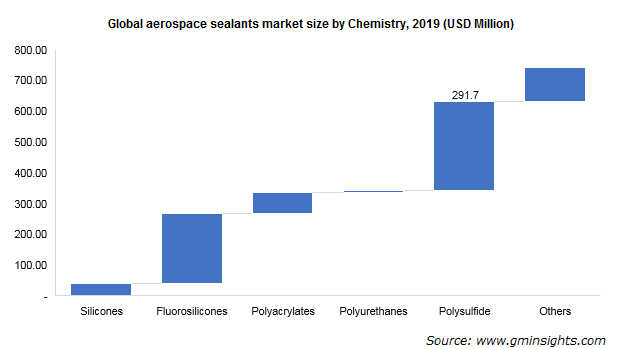Home > Pressrelease > Aerospace Sealant Market size worth $800 Mn by 2026
Aerospace Sealant Market size worth $800 Mn by 2026
- Published Date: May 11, 2020
Aerospace Sealant Market size is predicted to exceed USD 800 million by 2026, according to a new research report by Global Market Insights Inc.
Growing popularity for air travel is likely to encourage the aircraft manufacturers to ramp-up production of aircrafts to cater to the rising demand. Additionally, manufacturers are also focusing on reducing their order backlogs and increasing their aircraft deliveries every year. Moreover, the manufacturers are significantly investing in innovative technologies to improve the fuel efficiency of the aircraft in compliance with stringent regulations.
Manufacturers are also investing in new products for improving the underlying sealant performance along with enhancing its aesthetics. For instance, in January 2018, PPG announced the availability of its PPG PRO-SEAL 815M sealant spray advance samples for its customers, which would offer superior finish and limit the surface cure time of the applied polysulfide sealants to around two hours. This sealant was commercially available to all customers in March 2018.

Get more details on this report - Request Free Sample PDF
The Asia Pacific region is estimated to account for the highest market share of global new aircraft deliveries between 2019 and 2038. Also, it is likely to hold almost 42% of the total deliveries. Airlines in Europe and North America will together register for around 36% of the overall freight and passenger aircraft deliveries. Thus, the significant ramp-up in the production of aircraft will drive the consumption for aerospace sealants.
The aerospace sealant market from fluorosillicone segment is estimated to register 3% CAGR during the study period. Aerospace sealants comprising of fluorosilicone find usage in the sealing of aircraft fuel tanks due to its excellent resistance towards petroleum-based fuel and oil. However, it exhibits poor gas permeation resistance, thus, it is likely to lose its share to other chemistries.
Browse key industry insights spread across 246 pages with 294 market data tables & 24 figures & charts from the report, “Aerospace Sealants Market Size By Chemistry (Silicone, Fluorosilicone, Polyacrylate, Polyurethane, Polysulfide [Cured, Non-Cured]), By Application (Fuel Tank, Airframe, Flight Line Repair, Aircraft Windshield And Canopy, Fuselage), By Aircraft (Commercial [Narrow Body, Wide Body], Regional, Business, Helicopter, Military), By Distribution Channel (OEM, Aftermarket [Operator/Airline In-House, Airline Third Party, Independent MRO), Industry Analysis Report, Regional Outlook, Application Growth Potential, Price Trends, Competitive Market Share & Forecast, 2020 – 2026” in detail along with the table of contents:
https://www.gminsights.com/pressrelease/aerospace-sealants-market
The fuel tank application segment in the aerospace sealant market is poised to witness 5% growth rate through 2026. Fuel tanks structures are categorized into integral, rigid removable, and bladder. These structures are prone to leakages which causes trouble to the aircraft manufacturers and service providers. Integrated fuel tanks are positioned on wings that rely on aerospace sealants to ensure no leakage occurs through fasteners and joints.
The regional aircraft segment is estimated to grow at moderate CAGR of around 3.5% from 2020 to 2026. This can be attributed to the substantially surging demand for regional jets due to its optimized seating capacities coupled with a higher operating range. Moreover, these aircrafts are ideal for low-cost long/short haul distance commutes.
The operator/airline in-house segment is projected to cross USD 55 million by 2026 as aircraft manufacturers rely on outsourcing aerospace sealants and depend on the suppliers for smooth inventory. Thus, it is going to lose its share to airline third party and independent service providers.
North America aerospace sealant market is anticipated to hold over 30% share by 2026 on account of presence of the matured aerospace industry in the region. Boeing, Bombardier, Embraer, etc. are some of the leading aerospace manufacturers. An upsurge in aircraft manufacturing activities coupled with significant air travel rates is expected to augment the demand for aerospace sealants.
Some of the participants in the global aerospace sealant market include PPG Industries, Henkel, Dow Corning, 3M, Royal Adhesives & Sealants, Anabond Limited, Flamemaster Corporation, and Cytec Industries. Strategies such as capacity expansions and acquisitions are incorporated by key industry players to gain a significant position in the market.